Roque de los Muchachos Observatory
Roque de los Muchachos Observatory (Spanish: Observatorio del Roque de los Muchachos, ORM) is an astronomical observatory located in the municipality of Garafía on the island of La Palma in the Canary Islands. The observatory site is operated by the Instituto de Astrofísica de Canarias, based on nearby Tenerife. ORM is part of the European Northern Observatory.
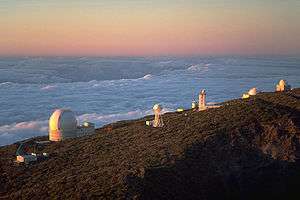 Overview of some of the telescopes at the Roque de los Muchachos Observatory. | |
| Alternative names | ORM |
|---|---|
| Organization | Instituto de Astrofísica de Canarias |
| Observatory code | 950 |
| Location | Roque de los Muchachos, Province of Santa Cruz de Tenerife, Spain |
| Coordinates | 28°45′49″N 17°53′41″W |
| Altitude | 2,396 m (7,861 ft) |
| Established | 29 June 1985 |
| Website | www |
| Telescopes | FACT (Telescope) Carlsberg Meridian Telescope Dutch Open Telescope Galileo National Telescope Gran Telescopio Canarias HEGRA Isaac Newton Group of Telescopes Isaac Newton Telescope Jacobus Kapteyn Telescope Liverpool Telescope MAGIC MASCARA Mercator Telescope Nordic Optical Telescope Swedish Solar Telescope Wide Angle Search for Planets William Herschel Telescope |
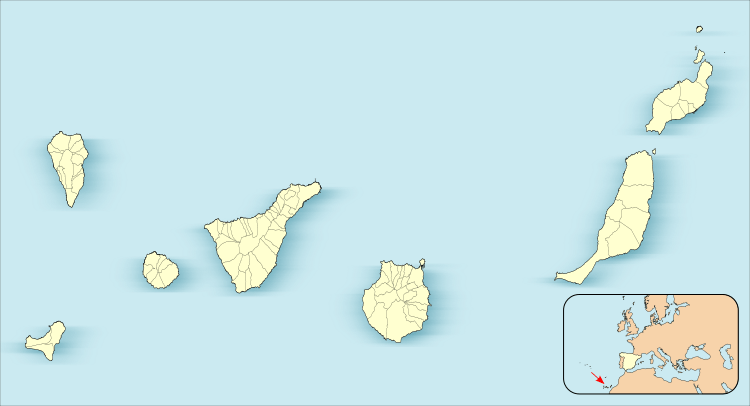 Location of Roque de los Muchachos Observatory | |
The seeing statistics at ORM make it the second-best location for optical and infrared astronomy in the Northern Hemisphere, after Mauna Kea Observatory, Hawaii. The site also has some of the most extensive astronomical facilities in the Northern Hemisphere; its fleet of telescopes includes the 10.4 m Gran Telescopio Canarias, the world's largest single-aperture optical telescope as of July 2009,[1] the William Herschel Telescope (second largest in Europe), and the adaptive optics corrected Swedish 1-m Solar Telescope.
The observatory was established in 1985, after 15 years of international work and cooperation of several countries with the Spanish island hosting many telescopes from Britain, The Netherlands, Spain, and other countries. The island provided better seeing conditions for the telescopes that had been moved to Herstmonceux by the Royal Greenwich Observatory, including the 98 inch aperture Isaac Newton Telescope (the largest reflector in Europe at that time). When it was moved to the island it was upgraded to a 100-inch (2.54 meter), and many even larger telescopes from various nations would be hosted there.
History
The building of the observatory traces to 1969, with the start of the Northern Hemisphere Observatory project.[2] After ten years of research on the site there is big international agreement with several nations to establish an international Observatory at La Palma.[3]
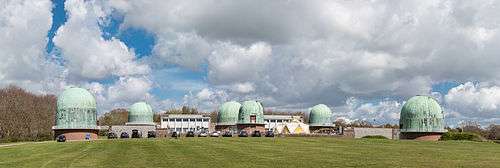
The observatory began operation around 1984 with the Isaac Newton Telescope, which was moved to La Palma from the Royal Greenwich Observatory site at Herstmonceux Castle in Sussex, England. The move was troubled, and it is widely recognized that it would have been cheaper to build a new telescope on-site rather than to move an existing one.
The observatory was first staffed by representatives from Spain, Sweden, Denmark and the United Kingdom. Other countries which became involved later include Germany, Italy, Norway, the Netherlands, Finland, Iceland, and the United States.
The observatory was officially inaugurated on June 29, 1985, by the Spanish royal family and six European heads of state. Four helicopter pads were built at the observatory to allow the dignitaries to arrive in comfort. The observatory has expanded considerably over time, with the 4.2m William Herschel Telescope opened in 1987, the Nordic Optical Telescope in 1988 and several smaller solar or specialized telescopes; the Galileo National Telescope opened in 1998 and the Gran Telescopio Canarias opened in 2006, with its full aperture in 2009.
A fire on the mountainside in 1997 damaged one of the gamma-ray telescopes, but subsequent fires in September 2005 and August 2009[4] did no serious damage to buildings or telescopes.
In 2016, the Instituto de Astrofisica de Canarias and Cherenkov Telescope Array Observatory signed an agreement to host Cherenkov Telescope Array’s northern hemisphere array at the ORM.
In 2016, the observatory was announced as the second-choice location for the Thirty Meter Telescope, in the event that the Mauna Kea site is not feasible.[5]
Telescopes/observatories
The Spanish island is host to the premiere collection of telescopes and observatories from around the World, for the northern hemisphere excluding the Hawaiian islands which has a different mix of telescopes. However, even the southern hemisphere there is no equal to the 10.4 meter Grand Telescope Canarias, which has the largest single aperture for an astronomical observatory in the World.
- FACT
- Carlsberg Meridian Telescope (1984-2013)
- Dutch Open Telescope
- Galileo National Telescope
- Gran Telescopio Canarias (2007- )
- HEGRA
- Isaac Newton Telescope
- Jacobus Kapteyn Telescope
- Liverpool Telescope (2003- )[6]
- MAGIC
- MASCARA
- Mercator Telescope
- Nordic Optical Telescope
- Swedish Solar Telescope
- Wide Angle Search for Planets (WASP)
- William Herschel Telescope
Gallery
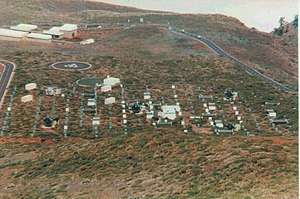 Several of the helicopter pads built for the inauguration ceremony can be seen under the now dismantled HEGRA array
Several of the helicopter pads built for the inauguration ceremony can be seen under the now dismantled HEGRA array
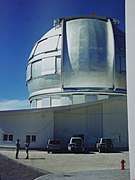 Picture of the 10m Gran Telescopio Canarias building under construction in March 2003
Picture of the 10m Gran Telescopio Canarias building under construction in March 2003- Picture of the Nordic Optical Telescope (NOT)
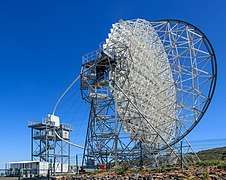 Large-Sized-Telescope 1 of the Cherenkov Telescope Array
Large-Sized-Telescope 1 of the Cherenkov Telescope Array

See also
- Roque de los Muchachos
- La Palma
- Instituto de Astrofísica de Canarias
- Teide Observatory
- Isaac Newton Group
- Astronomical seeing
- Gran Telescopio Canarias
- List of space telescopes (Another important source of astronomical observations in this period)
References
- Klotz, Irene (24 July 2009). "New telescope is world's largest ... for now". Discovery. Archived from the original on 9 April 2013. Retrieved 27 May 2019 – via NBC News.
- "Fires rage across Canary island". BBC News. 3 August 2009. Archived from the original on 2 August 2009. Retrieved 12 July 2013.
- "Statement Regarding Selection of Alternate Site for TMT". Thirty Meter Telescope. 31 October 2016. Archived from the original on 1 November 2016. Retrieved 1 November 2016.
- Leverington, David (2017). Observatories and Telescopes of Modern Times. Cambridge University Press. ISBN 9780521899932.
External links
| Wikimedia Commons has media related to Roque de los Muchachos Observatory. |